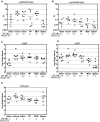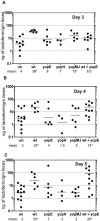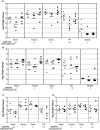The proinflammatory response induced by wild-type Yersinia pseudotuberculosis infection inhibits survival of yop mutants in the gastrointestinal tract and Peyer's patches
- PMID: 16495522
- PMCID: PMC1418670
- DOI: 10.1128/IAI.74.3.1516-1527.2006
The proinflammatory response induced by wild-type Yersinia pseudotuberculosis infection inhibits survival of yop mutants in the gastrointestinal tract and Peyer's patches
Abstract
Single-strain infections and coinfections are frequently used to assess roles of virulence factors in infected tissues. After oral inoculation of mice, Yersinia pseudotuberculosis yopE and yopH mutants colonize the intestines and Peyer's patches in single-strain infections but fail to persist in competition with wild-type Y. pseudotuberculosis, indicating that these two infection models provide different insights into the roles of Yops. To determine how wild-type Y. pseudotuberculosis hinders yop mutant survival, yop mutant colonization and host responses were investigated in several different infection models that isolated specific features of wild-type Y. pseudotuberculosis infection. Infection with wild-type Y. pseudotuberculosis caused significantly more inflammation than yop mutants. Results from coinfections of gamma interferon (IFN-gamma)-/- mice revealed that IFN-gamma-regulated defenses target these mutants, suggesting that YopE and YopH protect Y. pseudotuberculosis from these defenses in BALB/c mice. We developed an oral-intraperitoneal infection model to evaluate the effects of spleen and liver colonization by Y. pseudotuberculosis on yop mutants in the intestines. Spleen and liver infection increased inflammation and decreased yop mutant survival in the intestines, indicating that infection of these organs has consequences in intestinal tissues. Finally, competition infections with Y. pseudotuberculosis mutants with various abilities to induce inflammation demonstrated that survival of the yopE, but not the yopH, mutant was consistently decreased in inflamed tissues. In summary, infection with Y. pseudotuberculosis in intestinal and systemic sites induces intestinal inflammation, which decreases yop mutant survival. Thus, competition studies with wild-type yersiniae reveal critical roles of Yops in combating host responses to a normal virulent infection.
Figures







References
-
- Alonso, A., N. Bottini, S. Bruckner, S. Rahmouni, S. Williams, S. P. Schoenberger, and T. Mustelin. 2004. Lck dephosphorylation at Tyr-394 and inhibition of T cell antigen receptor signaling by Yersinia phosphatase YopH. J. Biol. Chem. 279:4922-4928. - PubMed
-
- Bjune, G., T. E. Ruud, and J. Eng. 1984. Bacterial shock due to transfusion with Yersinia enterocolitica infected blood. Scand. J. Infect. Dis. 16:411-412. - PubMed
-
- Black, D. S., and J. B. Bliska. 2000. The RhoGAP activity of the Yersinia pseudotuberculosis cytotoxin YopE is required for antiphagocytic function and virulence. Mol. Microbiol. 37:515-527. - PubMed
Publication types
MeSH terms
Substances
Grants and funding
LinkOut - more resources
Full Text Sources

